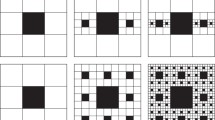Summary
The mammalian lung exhibits features of a fractal tree: heterogeneity, self-similarity and the absence of a characteristic scale. The finite nature of the lung ultimately limits the range over which self-similarity scaling characteristics are applicable. However, generalization based on the scaling features of fractals, provides unique insight into geometric organization of anatomic structures. Furthermore, the mathematical theory of renormalization groups provides a description of the harmonically-modulated inverse power-law scaling observed for bronchial tree dimensions observed in different species. Compared to several mammalian species (dog, rat, hamster), the human lung shows marked differences in the phase of the harmonic modulation for both length and diameter measurements. These inter-species scaling differences suggest that evolutionary factors modify certain universal features of morphogenesis.
Similar content being viewed by others
References
Weibel, E. R., and Gomez, D. M., Science127 (1962) 577.
Goldberger, A. L., and West, B. J., Yale J. biol. Med.60 (1988) 421.
Raabe, O., Yeh, H., Schum, G., and Phalen, R., Tracheobronchial Geometry: Human, Dog, Rat, Hamster (LF-53). Government Printing Office, Washington, DC 1976.
Horsfield, K., and Cumming, G., J. appl. Physiol.24 (1968) 373.
Horsfield, K., Dart, G., Olson, D., Filley, G., and Cumming, G., J. appl. Physiol.31 (1971) 207.
Parker, H., Horsfield, K., and Cumming, G., J. appl. Physiol.31 (1971) 386.
Phalen, R., Yeh, H., Schum, G., and Raabe, O., Anat. Rec.190 (1978) 167.
MacDonald, N., Trees and Networks in Biological Models. Wiley, New York 1983.
West, B. J., Bhargava, V., and Goldberger, A. L., J. appl. Physiol.60 (1986) 1089.
Shlesinger, M. F., and Hughes, B. D., Physica109A (1981) 597.
West, B. J., and Goldberger, A. L., Am. Scient.75 (1987) 354.
West, B. J., Fractals Intermittency and Morphogenesis, in: Chaos in Biological Systems. Eds. H. Degn, A. V. Holden and L. F. Olsen. Plenum, New York 1987.
Montroll, E. W., and Shlesinger, M. F., J. stat. Phys.32 (1983) 209–230.
Bevington, P. R., Data Reduction and Error Analysis for the Physical Sciences. McGraw-Hill, New York 1969.
Press, W. H., Flannery, B. P., Teukolsky, S. A., and Vetterling, W. T., Numerical Recipes. Cambridge University Press, New York 1986.
Author information
Authors and Affiliations
Rights and permissions
About this article
Cite this article
Nelson, T.R., West, B.J. & Goldberger, A.L. The fractal lung: Universal and species-related scaling patterns. Experientia 46, 251–254 (1990). https://doi.org/10.1007/BF01951755
Received:
Accepted:
Published:
Issue Date:
DOI: https://doi.org/10.1007/BF01951755




